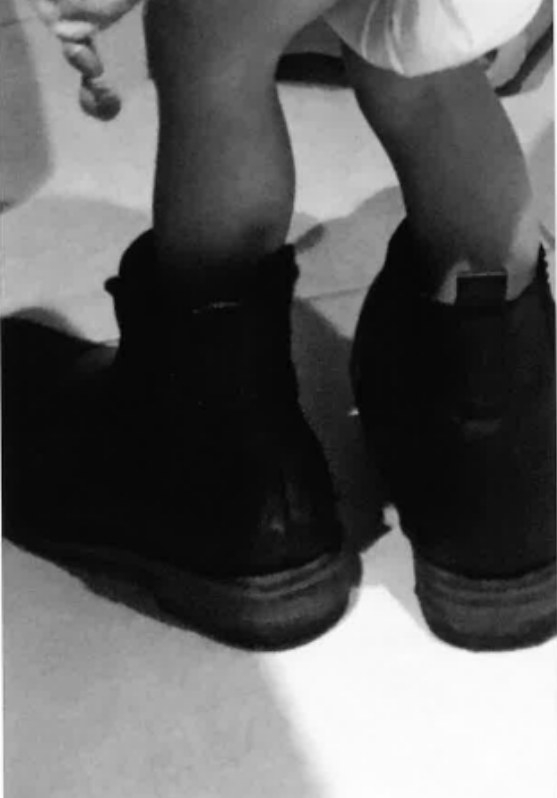When Words Are Not Enough - The Exhibition
The creation of our ‘When Words Are Not Enough’ art exhibition has been a long time in the making. The aim was to provide a platform for the voices that have risen from the shadows of domestic abuse. All that attended the exhibition were completely taken in by the resilience and courage of survivors – feeling the transformative power of art together.
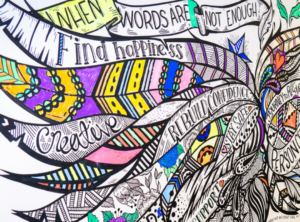
Walking into the new NIDAS offices for the ‘When Words Are Not Enough’ art exhibition, visitors were instantly ‘wowed’ with what they were about to experience.
After being greeted by members of the NIDAS team, visitors chose a refreshing drink before heading into the main exhibition room where the first masterpiece to be viewed was a large paint and crayon work of art created by DEAF-initley Women stood floor to ceiling. This particular art installation was created during a workshop ran by NIDAS Art Therapist, Hatty Pocock, where art was used to enable individuals to freely express themselves and be liberated from the stigma that can be associated with medicalised views of deafness. Read more about the DEAF-initely Women workshop here.
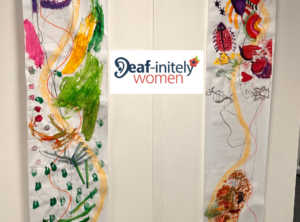
As visitors journeyed on, they were taken to an array of artwork covering different pencil drawings, paintings, photography, mixed media, and poetry. Within this section of the exhibition, a beautiful photograph entitled ‘Boots of Strength’, was an image that kept the artist going in times when she needed strength. Follow her journey of survival on a four-part blog she has written.
At the end of the first section, visitors could view the splendour of a magnificent patchwork quilt and cushions, created by Michelle Wightman. The quilt on display is a second one to be made, the original was created as a tribute to 598 women who lost their lives to domestic abuse between 2009 and 2016. The amazing spectacle at the exhibition covered the next period between 2016 and 2020, containing 7,002 names to honour Leighann Wightman who sadly gained her angel wings due to the mindless, selfish, and jealous rage of her then partner. Read more about the quilt and cushions below:
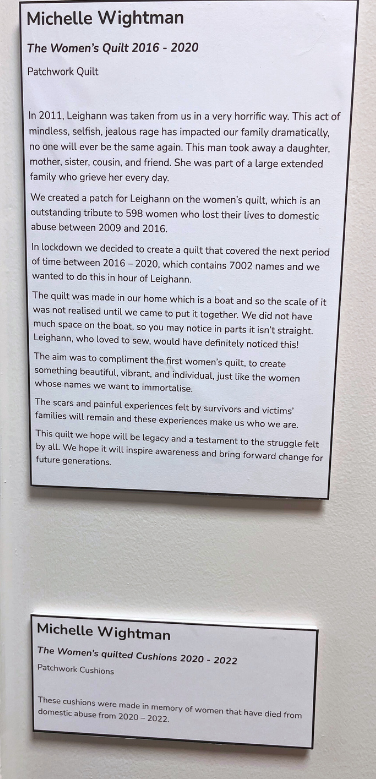
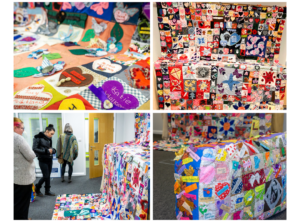
The practitioners at NIDAS wanted to contribute to the exhibition by spending a morning together as a team to focus on development and wellbeing. Hatty led an art activity that encouraged the team to focus on how they were feeling in the present moment and hold in mind the work they do for survivors of domestic abuse and how it may affect them. The team made images separately, which were then pieced together to create a cohesive whole, which was displayed opposite The Leighann Wightman Quilt.
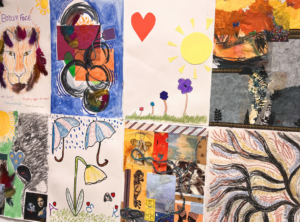
Turning the corner, visitors enjoyed more artwork, including some fantastic modelling clay figures of Sonic the Hedgehog, Knuckles, and Tails made by a talented child who attended Art Therapy sessions with NIDAS. Art made during Art Therapy doesn’t need to have meaning, simply expressing oneself in a non-verbal format is therapy itself. Another example of this is a piece created by a survivor who has found that art has helped them to explore their true self, it has given them confidence, and has allowed them to use art to escape when they feel overwhelmed.
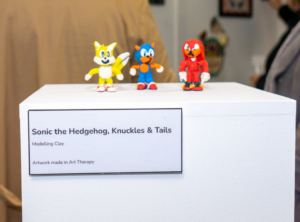
“Thanks to art, I can express myself and tell others how I am feeling without the use of words.” – Artist
In the same section of the exhibition, a survivor shared her four stages of being in a domestic abuse relationship with watercolour paintings on canvas. This storyboard style art piece tells the viewer so much about how artist and her story before reading her artwork explanation below.
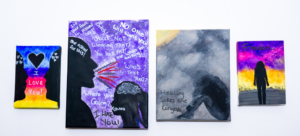
Across the hall, visitors were encouraged to enter a darkened room where they could sit and watch a wonderfully created stop motion film ‘The Revenge of Sausage’ by the artist and Hatty. Creating a stop motion animation during Art Therapy can provide a therapeutic narrative and opportunities for reflection for the client, as well as acting as a way into explorative role play to explore difficult feelings and emotions.
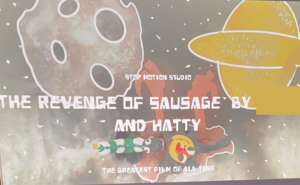
To complete the exhibition, visitors were encouraged to colour in a section on the incredible colouring board created by local artist Sabina Gran Design (see her details below). Sabina was commissioned to create a large board that reflects the exhibition as an artwork piece that everyone could take part in. So many visitors had a go, and some kept going back to do more.
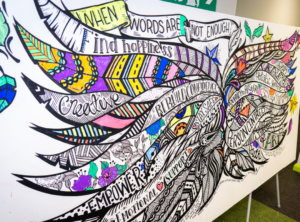
The piece had two large wings to represent ‘Being Free and Starting a New Journey’. The board design incorporated a poem written by one of the exhibition artists:
“Today was our day to be free
You kept us quiet so no one else could see, nor hear.
The hurt and pain you did, was only your eyes that seen.
You hurt my children, yet you didn’t care.
All they wanted was you to be there, to hold and love them the way I do.
But now we are free from pain to live our lives again.”
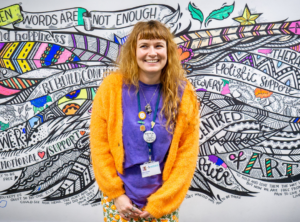
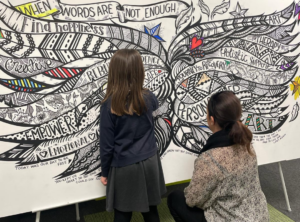
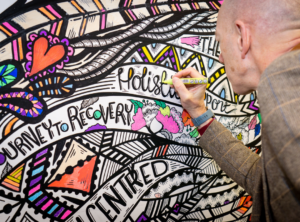
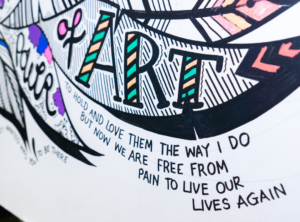
To give everyone the opportunity to come together, to talk, to reflect, and to discuss, a visually stunning and mouth-wateringly delicious grazing table was artfully crafted for all to enjoy – an amazing addition to the exhibition. The beautifully curated table included a variety of cheeses, breads, cold meats, fruits, vegetables, and sweet treats. The table was the creative concept of NIDAS CEO, Sarah Dagley.
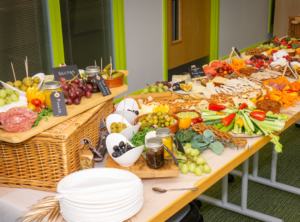
Hatty gave a wonderful welcome speech, which we would like to share to complete this blog.
“I want to express my deepest gratitude and thanks to the artists who have expressed their most inner thoughts and feelings onto paper and canvas, expressing emotions that words struggle to capture. Your work is not just artwork, it is a testament to the strength within, an act against the silence imposed by abuse. In the face of adversity, these survivors have been able to use art effectively as a tool for self-expression, each piece telling a powerful story, not just of pain but the healing and personal growth of each survivor. Art becomes a mirror reflecting the journey from darkness to light, a journey honoured at our exhibition.”
We hope that our ‘When Words Are Not Enough’ art exhibition acted as a call to break the silence surrounding domestic abuse. Together, we can help to amplify these voices and empower survivors to rewrite their narratives.
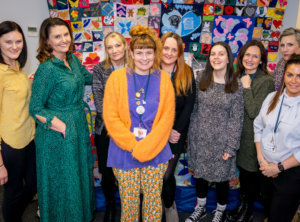
From all of us at NIDAS, we would like to thank:
- Survivors and artists taking part in the exhibition
- Hatty and the art therapy team
- The exhibition organisation team and all NIDAS staff
- Michelle Wightman and the National Trust for the kind loan of The Leighann Wightman Quilt
- Sabina Gran Design for the colouring board art installation
- All NIDAS trustees and funders
- DEAF-initley Women
- Richard Davies – DW Exhibition Ltd, Exhibition Specialists for supplying the exhibition boards to display all of the amazing artwork
- Dan Donovan for photographing the exhibition
- The anonymous donation of prosecco for visitor refreshments
